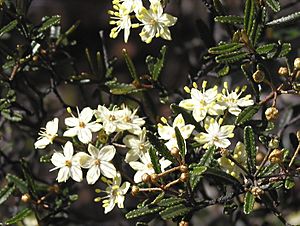Phebalium tuberculosum facts for kids
Quick facts for kids Phebalium tuberculosum |
|
|---|---|
 |
|
| Near Wongan Hills | |
| Scientific classification | |
| Genus: |
Phebalium
|
| Species: |
tuberculosum
|
| Synonyms | |
|
|
The Phebalium tuberculosum is a type of upright shrub that grows only in Western Australia. It has special branches and leaves that feel a bit bumpy and scaly. Its pretty white flowers grow in small bunches of three or four, and the back of their petals have cool rust-coloured scales.
Contents
What Does Phebalium tuberculosum Look Like?
The Phebalium tuberculosum is an upright shrub that usually grows to be about 0.3–4.0 m (1 ft 0 in – 13 ft 1 in) tall. Its branches, leaves, and the green parts that protect the flower (called sepals) are often bumpy.
Its leaves are shaped like long ovals, and their edges are rolled under, making them look almost like small tubes. They are about 4–7 mm (0.16–0.28 in) long and 1 mm (0.039 in) wide.
The flowers grow in small bunches of three or four. Each flower sits on a thick stalk, about 2–5 mm (0.079–0.197 in) long, which is covered with rust-coloured scales. The five sepals are 2–3 mm (0.079–0.118 in) long and are joined at the bottom. The petals are white, wide, and oval-shaped, measuring 3–4.5 mm (0.12–0.18 in) long and 2–3.5 mm (0.079–0.138 in) wide. The back of the petals has shiny silver to rust-coloured scales. This plant usually blooms from September to December.
How This Plant Got Its Name
Scientists give plants special names. This plant was first officially named in 1862 by a scientist called Ferdinand von Mueller. He called it Eriostemon tuberculosus and wrote about it in his book, The Plants Indigenous to the Colony of Victoria.
The very next year, another scientist named George Bentham changed its name to Phebalium tuberculosum. He published this new name in his book, Flora Australiensis.
Where Does Phebalium tuberculosum Grow?
You can find Phebalium tuberculosum growing on rocky hills, sandy areas, and flat plains in Western Australia. It grows in a wide area between places like Kalbarri, Katanning, and Zanthus.
Is This Plant Endangered?
The Government of Western Australia's Department of Parks and Wildlife says that this type of phebalium is "not threatened." This means there are enough of these plants, and they are not currently at risk of disappearing.

